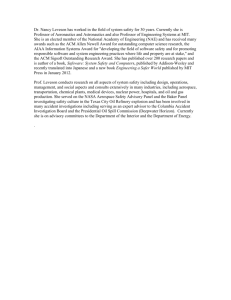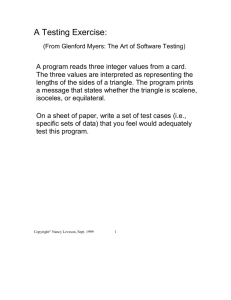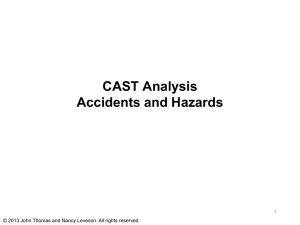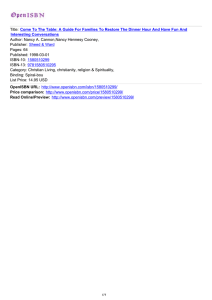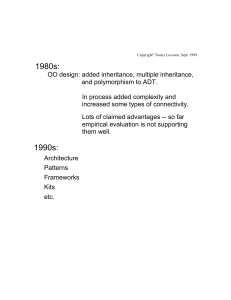Basic Design for Safety Principles 1
advertisement
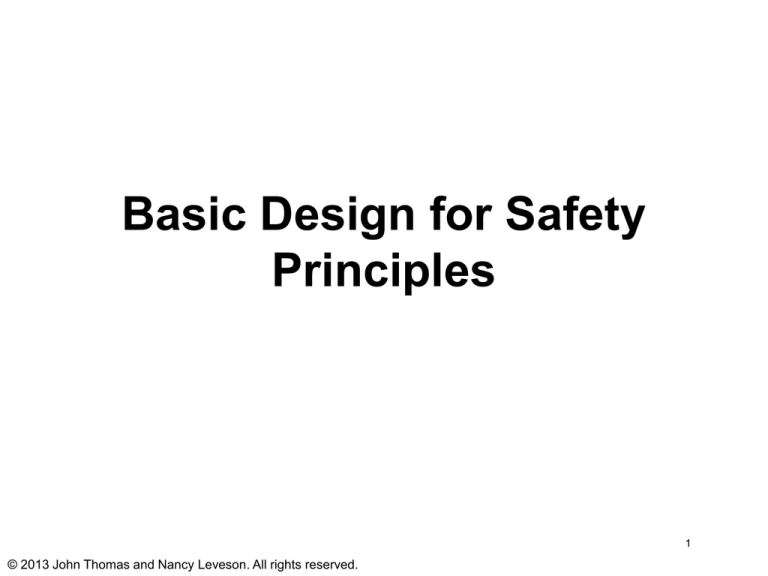
Basic Design for Safety Principles 1 © 2013 John Thomas and Nancy Leveson. All rights reserved. Designing to Prevent Accidents • Standards and codes of practice contain lessons learned from the past • Try to eliminate hazards from the design • Identify causes of hazards and try to reduce their likelihood of occurring through design • Control hazards once they occur • Design to reduce damage 2 © 2013 John Thomas and Nancy Leveson. All rights reserved. Preventing component failures is not enough Image: Public Domain. Figure 4: The DO-312 Approach to Hazard Definition. Fleming, Cody Harrison, Melissa Spencer, Nancy Leveson et al. “Safety Assurance in NextGen.” March 2012. NASA/CR–2012-217553. Accidents result from more than just component failures 3 © 2013 John Thomas and Nancy Leveson. All rights reserved. 4 © 2013 John Thomas and Nancy Leveson. All rights reserved. Hazard Elimination • Substitution – Use safe or safer materials – Nontoxins, non-explosives – Chlorine blower example • Simplification – Minimize parts, modes, interfaces – Reduce “unknowns” – Computers make it easy to build dangerously complex systems 5 © 2013 John Thomas and Nancy Leveson. All rights reserved. Image removed due to copyright restrictions. See: http://users_v2.section101.com/memberdata/ru/rubegoldberg/photos/rubeg oldberg_photo_gal_4156_photo_909168941_lr.jpg 6 © 2013 John Thomas and Nancy Leveson. All rights reserved. Elimination (2) • Decoupling: – Tightly coupled system is one that is highly interdependent – Coupling increases number of interfaces and leads to unplanned interactions – Computers tend to increase system coupling unless very careful. • Reduce opportunities for human error – Make impossible or possible to detect immediately – Examples: wiring errors (color code, female/male connectors), typos, making displays readable, showing status of plant • Reduce hazardous materials or conditions – Example: keep fewer hazardous chemicals on hand 7 © 2013 John Thomas and Nancy Leveson. All rights reserved. Hazard Reduction • Try to minimize likelihood of hazard occurring 8 © 2013 John Thomas and Nancy Leveson. All rights reserved. Passive vs. Active Protection • Passive safeguards: – Maintain safety by their presence – Fail into safe states • Active safeguards: – Require hazard or condition to be detected and corrected Tradeoffs – Passive rely on physical principles – Active depend on less reliable detection and recovery mechanisms BUT – Passive tend to be more restrictive in terms of design freedom and not always feasible to implement 9 © 2013 John Thomas and Nancy Leveson. All rights reserved. Fail-Safe (Passive) Safeguards Examples • Design so system fails into a safe state Examples: – Deadman switch – Magnetic latch on refrigerators – Railroad semaphores: if cable breaks, fails into STOP position – Cover over a high-energy source with circuit run through it – Relays or valves designed to fail open or fail safe – Air brakes: held in off position by air pressure. If line breaks, lose air pressure and brakes applied – Early Apollo program: use free return trajectory. If engines failed at lunar orbit insertion, spacecraft safely coasts back to earth 10 © 2013 John Thomas and Nancy Leveson. All rights reserved. More Examples • Retractible landing gear: wheels drop and lock into position if system that raises and lowers them fails (e.g., pneumatic pressure system) • Elevator: if hoist cables fail, safety mechanism wedges into guide rails • Bathyscope: ballast held in place by magnets. If electrical power lost, ballast released and ascends to surface • Railway signalling systems: signals not in use kept in “danger” position. Positive action required (setting signal to clear) is required before train can pass. • Design cars so drivable with one flat tire. Also “run-flat tires” with solid rubber core 11 © 2013 John Thomas and Nancy Leveson. All rights reserved. Redundancy – Deepwater Horizon M 1 1 B 2 B 2 M Switching the battery and the motor ensures a stuck switch (caused for example by an arm sticking at a contact) will not hurt the battery. The motor can be shorted without harm. Image by MIT OpenCourseWare. Based on the motor reversing system from Martin, Mike W. and Roland Schinzinger. Ethics in Engineering. McGraw-Hill Book Company, 1989. 12 © 2013 John Thomas and Nancy Leveson. All rights reserved. Design for Controllability • Make system easier to control, both for humans and computers – Use incremental control • Perform critical steps incrementally rather than in one step • Provide feedback – To test validity of assumptions and models upon which decisions are made – To allow taking corrective action before significant damage is done • Provide various types of fallback or intermediate states – Lower time pressures – Provide decision aids 13 © 2013 John Thomas and Nancy Leveson. All rights reserved. Monitoring • To detect a problem need to – Check conditions that are assumed to indicate a potential problem – Validate or refute assumptions made during design and analysis • Can be used to indicate – – – – – Whether a specific condition exists Whether a device ready for operation or operating satisfactorily Whether required input is being provided Whether a desired or undesired output is being generated Whether a specific limit being exceeded or whether a measures parameter is abnormal • Need to design for checkability and inspectability 14 © 2013 John Thomas and Nancy Leveson. All rights reserved. Monitoring (2) • Two ways to detect equipment malfunction: – Monitor equipment performance (requires redundant info) – Monitor equipment condition • In general, monitors should – Detect problems as soon as possible – Be independent from devices they are monitoring – Add as little complexity to system as possible – Be easy to maintain, check, and calibrate – Be easily interpreted by operators (e.g., mark limits on dials) 15 © 2013 John Thomas and Nancy Leveson. All rights reserved. Limitations of Monitoring • Difficult to make monitors independent – Checks usually require access to information being monitored, but usually involves possibility of corrupting that information – Depends on assumptions about behavior of system and about errors that may or may not occur • May be incorrect under certain conditions • Common incorrect assumptions may be reflected both in design of monitor and devices being monitored. 16 © 2013 John Thomas and Nancy Leveson. All rights reserved. Barriers Lockout • Make access to dangerous state difficult or impossible • Fences and physical barriers to block access to a dangerous condition (sharp blades, heated surfaces, high-voltage equipment) • Logical barriers (authority limiting, software firewalls) 17 © 2013 John Thomas and Nancy Leveson. All rights reserved. Barriers (2) Lockin • Make it difficult or impossible to leave a safe state, maintain a safe condition • Possible uses: – Keep humans within an enclosure, e.g., seatbelts and harnesses, doors on elevators – Contain harmful products or byproducts, e.g., electromagnetic radiation, pressure, noise, toxins, ionizing radiation – Contain potentially harmful objects, e.g., cages around an industrial robot in case it throws something – Maintain a controlled environment (e.g., buildings, spacecraft, space suits, diving suits) – Maintain a safe state (e.g. speed governors, relief valves to maintain pressure below dangerous levels) 18 © 2013 John Thomas and Nancy Leveson. All rights reserved. Barriers (3) Interlock • Used to enforce a sequence of actions or events 1. Event A does not occur inadvertently 2. Event A does not occur while condition C exists 3. Event A occurs before event D • (1) and (2) are called “inhibits”, (3) is a “sequencer” • Examples: – – Pressure sensitive mat or light curtain that shuts off a robot if someone comes near Deadman switch – Guard gates and signals at railway crossings 19 © 2013 John Thomas and Nancy Leveson. All rights reserved. Barriers (4) • Examples (con’t): – Device on machinery to ensure all prestart conditions met, correct startup sequence followed, conditions for transitions between phases are met – Device to ensure correct sequencing of valve turnoff or turnon or both not on or off at same time. – Devices to preventing disarming a trip (protection) system unless certain conditions occur first or to prevent system from being left in disabled state after testing or maintenance – Disabling car ignition unless automatic shift in PARK – Freeze plug in a car’s engine cooling system (expansion will force plug out rather than crack cylinder if water in block freezes) – Fusible plug in boiler becomes exposed if excessive heat and water level drops below predetermined level. Plug melts, opening permits steam to escape, reduces pressure in boiler, and prevents explosion. 20 © 2013 John Thomas and Nancy Leveson. All rights reserved. Accident with No Component Failures Courtesy of Elsevier, Inc., http://www.sciencedirect.com. Used with permission. © 2013 John Thomas and Nancy Leveson. All rights reserved. 21 Barriers (5) • Design Considerations – Design so hazardous functions stop if interlock – If interlock brings something to a halt, provide status and alarm information to indicate which interlock failed. – If use interlock during maintenance or testing, must preclude inadvertent interlock overrides or being left inoperative once system becomes operational again. – When computers introduced, physical interlocks may be defeated or omitted. • Software programmers may not understand physical devices they are replacing. • May still need physical interlocks to protect against software errors. • Make sure in safe state when resume operation, don’t just start from where left off. Remember, the more complex the design, the more likely errors or hazards will be introduced by the protection facilities themselves. 22 © 2013 John Thomas and Nancy Leveson. All rights reserved. Safety Factors and Safety Margins • Appropriate for structures and non-action systems • Used to cope with uncertainties in engineering – Inaccurate calculations or models – Limitations in scientific knowledge such as behavior in extreme conditions – Variation in strength of a specific material due to differences in composition, manufacturing, assembly, handling, environment, or usage. – Incomplete knowledge about operational environment • So design component to withstand greater stresses than anticipated to occur 23 © 2013 John Thomas and Nancy Leveson. All rights reserved. Safety Factors and Safety Margins (2) • Safety factor is expressed as ratio of nominal or expected strength to nominal stress (load). – e.g., Part with safety factor of two theoretically able to withstand twice expected stress. • Limitation: – Particular components may differ from average (Averages imply a range of values over which a particular characteristic may vary) – Even more difficult for continually changing stresses • Partial solutions but does not eliminate problem: – Compare minimum probable strength and maximum probable stress (called “safety margin”). – Compute ratio at specific standard deviations from mean • Solutions involve increased cost 24 © 2013 John Thomas and Nancy Leveson. All rights reserved. © Copyright Nancy Leveson, Aug. 2006 Safety factor Probability of occurrence Probability of occurrence Expected failure strength Expected Expected load Margin strength of safety Stress (A) Probability density function of failure for two parts with same expected failure strength. Stress (B) A relatively safe case. Safety factor Probability of occurrence Expected load Expected strength Stress (C) A dangerous overlap but the safety factor is the same as in (b). Image by MIT OpenCourseWare. 25 Fault or Failure Tolerance • Goal is to “tolerate” faults so they have no or little negative impact – Isolation or independence: so that misbehavior of one component does not negatively affect behavior of another – Failure warnings and indicators: to provide early detection of failures so preventive actions can be taken – Carefully designed and practiced flight crew procedures to enable safe flight and landing when problems occur – Design to tolerate human error – Physical damage tolerance: ability to sustain damage without hazard resulting. – Eliminate impact of common hardware failures on software • E.g., do not use 1 or 0 to denote safe vs. armed 26 © 2013 John Thomas and Nancy Leveson. All rights reserved. Redundancy • Goal is to increase component reliability and reduce component failures • Standby spares vs. concurrent use of multiple devices (with voting) • Identical designs or intentionally different ones (diversity) • Diversity must be carefully planned to reduce dependencies • Can also introduce dependencies in maintenance, testing, repair 27 © 2013 John Thomas and Nancy Leveson. All rights reserved. Triple Modular Redundancy F Voter F F Image by MIT OpenCourseWare. Standby Sparing F Switch F Image by MIT OpenCourseWare. 28 Redundancy (2) • Identical designs or intentionally different ones (diversity) • Diversity must be carefully planned to reduce dependencies • Problem is potential lack of independence – Common mode failures: fail in same way, causes may be different – Common cause failure: Fail due to same cause • Can also introduce dependencies in maintenance, testing, repair 29 © 2013 John Thomas and Nancy Leveson. All rights reserved. Redundancy (3) • Limitations – Common-cause and common-mode failures – May add so much complexity that causes failures – More likely to operate spuriously – May lead to false confidence (Challenger) – Extra costs including maintenance and extra weight • Useful to reduce hardware failures. But what about software? – Ariane 5 loss – Design redundancy vs. design diversity – Bottom line: Claims that multiple version software will achieve ultra-high reliability levels are not supported by empirical data or theoretical models 30 © 2013 John Thomas and Nancy Leveson. All rights reserved. Software Redundancy • Software errors are design errors – Data redundancy: extra data for detecting errors: e.g., parity bit and other codes checksums message sequence numbers duplicate pointers and other structural information – Algorithmic redundancy: 1. Acceptance tests (hard to write) 2. Multiple versions with voting on results 3. Found to have lots of common faults 31 © 2013 John Thomas and Nancy Leveson. All rights reserved. Software Recovery • Backward – Assume can detect error before does any damage – Assume alternative will be more effective • Forward – Robust data structures – Dynamically altering flow of control – Ignoring single cycle errors • But real problem is detecting erroneous states 32 © 2013 John Thomas and Nancy Leveson. All rights reserved. Example: Nuclear Detonation • Safety depends on NOT working • Three basic techniques (callled “positive measures”) 1. Isolation – Separate critical elements 2. Inoperability – Keep in inoperable state, e.g., remove ignition device or arming pin 3. Incompatibility – Detonation requires an unambiguous indication of human intent be communicated to weapon – Protecting entire communication system against all credible abnormal environments (including sabotage) not practical. – Instead, use unique signal of sufficient information complexity that unlikely to be generated by an abnormal environment 33 © 2013 John Thomas and Nancy Leveson. All rights reserved. Example: Nuclear Detonation (2) • Unique signal discriminators must 1. Accept proper unique signal while rejecting spurious inputs 2. Have rejection logic that is highly immune to abnormal environments 3. Provide predictable safe response to abnormal environment 4. Be analyzable and testable • Protect unique signal sources by barriers • Removable barrier between these sources and communication channels 34 © 2013 John Thomas and Nancy Leveson. All rights reserved. Example: Nuclear Detonation (3) Unique Signal Source Barrier Human intent Removable barrier Discriminator/Driver Inclusion Region Communications channel incompatible - Unique signal Inoperable in abnormal environments Stored UQS Arming and firing voltages Isolated component UQS Reader Isolated element Exclusion Region Image by MIT OpenCourseWare. 35 © 2013 John Thomas and Nancy Leveson. All rights reserved. Example: Nuclear Detonation (4) Stimuli Source Communication System Intended human action Safing and Firing System Unique signal no. 1 Intended human action AABABBB Intended human action Arming and fusing system Unique signal no. 2 Arming signal Human-machine interface Image by MIT OpenCourseWare. 36 Hazard Control • Detect hazard and control it before damage occurs – May be able to reverse it before necessary environmental conditions occur – Resources (physical and informational, such as diagnostics and status information) may be needed to control hazard • First need to detect hazard – Warning signals should be not present for too long or too frequently (people become insensitive to constant stimuli) • Do not assume hazard will never occur because of other protection devices or because software “never fails” 37 © 2013 John Thomas and Nancy Leveson. All rights reserved. Hazard Control LIMITING EXPOSURE (level or duration of hazard) – Stay in safe state as long and as much as possible e.g., nitroglycerine used to be manufactured in a large batch reactor. Now made in small continuous reactor and residence time reduced from 2 hours to 2 minutes. – Start out in safe state and require deliberate change to unsafe state e.g., arm missile only when near target NPP shutdown software keeps variables in “trip” state and requires change to non-trip. – Critical conditions should not be complementary, e.g., absence of an arm condition should not be used to indicate system is unarmed 38 © 2013 John Thomas and Nancy Leveson. All rights reserved. Hazard Control ISOLATION AND CONTAINMENT • Provide barriers between system and environment e.g., containment vessels and shields • Very hard to maintain over time PROTECTION SYSTEMS AND FAIL-SAFE DESIGN • Move system to a safe or safer state – Requires existence of a safe state (shutdown in NPP, sleep state in spacecraft cruise mode) – Also requires an early warning with enough time between detection of hazard and actual loss event 39 © 2013 John Thomas and Nancy Leveson. All rights reserved. Protection Systems and Fail-Safe Design • May have multiple safe states, depending on process conditions • General rule is hazardous states should be hard to get into and safe states should be easy • Typical protective equipment: – Gas detectors – Emergency isolation valves – Trips and alarms – Relief valves and flarestacks – Water curtains – Firefighting equipment – Nitrogen blanketing 40 © 2013 John Thomas and Nancy Leveson. All rights reserved. Protection Systems and Fail-Safe Design (2) • Panic Button: stops a device quickly, perhaps by cutting off power – Must be within reach when needed – Operators must be trained to react quickly to unexpected events • Passive devices better than active again • Watchdog timer: Timer that system must keep restarting. If not then takes protective action • Sanity checks (I’m alive signals): detects failure of computers • Protection system should provide information about its control actions and status to operators or bystanders. 41 © 2013 John Thomas and Nancy Leveson. All rights reserved. Protection Systems and Fail-Safe Design (3) • Designed failure path: direct failure along a less critical path – Example: jet engine mounted on wing by a pylon structure. Severe engine unbalance caused by loss of a number of fan blades from “foreign object ingestion” could destroy wing. But pylon and engine mount system designed to fail under these loads before main wing structure, allowing engine to fall harmlessly from airplane. • Failure containment: limit effects of failure or hazard to local area 42 © 2013 John Thomas and Nancy Leveson. All rights reserved. Protection Systems and Fail-Safe Design (4) • The easier and faster is return of system to operational state, the less likely protection system will be purposely bypassed or turned off • Try to control hazard while causing least damage in process • May need to do more than simply shut down, e.g., blowing up an errant rocket. – Such facilities may do harm themselves, e.g., French weather balloon emergency destruct facility, if inadvertently initiated • May design various types of fallback states – e.g., traffic lights that fail to blinking red or yellow states, unstable aircraft have analog backup devices because cannot be flown manually (but less functionality) 43 © 2013 John Thomas and Nancy Leveson. All rights reserved. Protection Systems and Fail-Safe Design (5) • Types of fallback states: – Partial shutdown (partial or degraded functionality) – Hold (no functionality provided, but steps taken to maintain safety or limit amount of damage) – Emergency shutdown (system shut down completely) – Manually or externally controlled – Restart (system in transitional state from non-normal to normal) • Conditions under which each of control modes should be invoked must be determined, along with how transitions between states will be implemented and controlled. 44 © 2013 John Thomas and Nancy Leveson. All rights reserved. Protection Systems and Fail-Safe Design (6) • May need multiple types of shutdown procedures – Normal emergency stop (cut power from all circuits) – Production stop (stop after current task completed) – Protection stop (shut down immediately but not necessarily by cutting power from circuits, which could result in damage). • If cannot design to fail into safe state or passively change to safe state, the hazard detectors must be of ultra-high reliability. – May add equipment to test detection system periodically by simulating condition sensor is supposed to detect (e.g., challenge system) – Challenge system must not obscure a real hazard and must be independent from monitor system 45 © 2013 John Thomas and Nancy Leveson. All rights reserved. Protection Systems and Fail-Safe Design (7) • Hazard detection system may have three subsystems: – Sensor to detect hazardous condition – Challenge subsystem to exercise and test sensor – Monitor subsystem to watch for any interruption of challenge-and-response sequence. • Note that complexity creeping up, decreasing probability they will work when needed. 46 © 2013 John Thomas and Nancy Leveson. All rights reserved. Damage Reduction • In emergency, may not be time to assess situation, diagnose what is wrong, determine correct action, and the carry out action. – Need to prepare emergency procedures and practice them – May need to determine a “point of no return” where recovery no longer possible or likely and should just try to minimize damage. • Distinguish between warnings used for drills and those for real emergencies • Damage minimization includes – Escape routes – Safe abandonment of products and materials (e.g., hazardous waste disposal) – Devices for limiting damage to people or equipment (e.g., blowout panels and frangible walls, collapsible steering columns on cars, sheer pins in motor-driven equipment 47 © 2013 John Thomas and Nancy Leveson. All rights reserved. Design Modification and Maintenance • Need to re-analyze safety for every proposed/implemented change • Recording design rationale from beginning and traceability will help. 48 © 2013 John Thomas and Nancy Leveson. All rights reserved. MIT OpenCourseWare http://ocw.mit.edu 16.63J / ESD.03J System Safety Fall 2012 For information about citing these materials or our Terms of Use, visit: http://ocw.mit.edu/terms.
